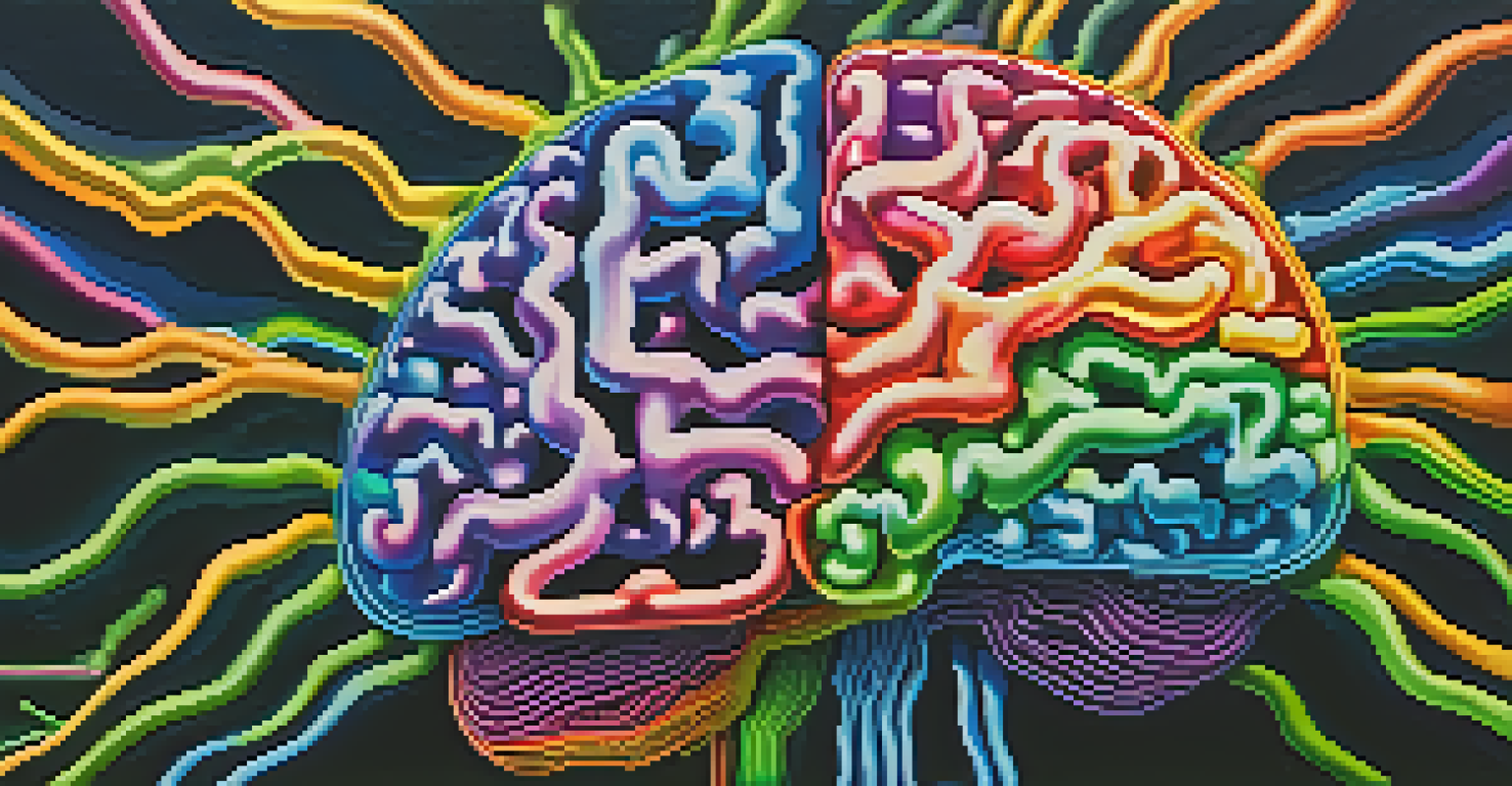Psychedelic Therapy: Science Behind Healing Through Hallucinogens

Understanding Psychedelic Therapy and Its Roots
Psychedelic therapy combines the use of hallucinogenic substances with psychotherapy to enhance mental health treatment. This approach has roots in ancient cultures, where substances like psilocybin and mescaline were used for healing and spiritual exploration. In recent years, a resurgence of interest in psychedelics has led scientists to investigate their therapeutic potential in treating conditions like depression, anxiety, and PTSD.
The use of psychedelics in therapy is not about the substances themselves, but about the profound healing experience they can facilitate when paired with the right support and environment.
The journey back to mainstream acceptance began in the mid-20th century when researchers first explored the effects of psychedelics. However, the counterculture movement of the 1960s led to a backlash, resulting in strict regulations. Today, with a renewed focus on mental health, researchers are once again looking at psychedelics as viable therapeutic tools, sparking a new wave of clinical studies.
This therapy is not just about the substances themselves; it also emphasizes the importance of the setting and the therapeutic relationship. A safe and supportive environment, along with trained professionals, can significantly enhance the healing experience, allowing patients to confront deep-seated issues during their psychedelic journey.
The Science Behind Psychedelics and Mental Health
Psychedelics work by interacting with serotonin receptors in the brain, particularly the 5-HT2A receptor, which is linked to mood regulation and perception. This interaction can lead to altered states of consciousness, which may help patients gain new perspectives on their thoughts and feelings. As a result, they can break free from negative thought patterns often associated with mental health disorders.

Research has shown that psychedelics can promote neuroplasticity—the brain's ability to reorganize itself by forming new neural connections. This is particularly beneficial for individuals with depression and anxiety, as it may allow them to develop healthier coping mechanisms. Moreover, studies indicate that psychedelics can foster emotional release, enabling patients to process trauma and grief more effectively.
Psychedelic Therapy's Historical Roots
Psychedelic therapy has ancient origins, with substances like psilocybin and mescaline being used historically for healing and spiritual exploration.
In clinical trials, substances like psilocybin and MDMA have shown promising results in reducing symptoms of anxiety and depression. For example, a recent study found that patients with treatment-resistant depression experienced significant improvements in their condition after just a few sessions of psilocybin therapy. This growing body of evidence is encouraging further exploration into the therapeutic benefits of psychedelics.
Key Components of Psychedelic Therapy Sessions
Psychedelic therapy typically involves several key components that work together to facilitate healing. First and foremost is the preparatory phase, where therapists help patients set intentions for their experience and address any fears or concerns. This groundwork is crucial, as it creates a foundation of trust and safety, allowing individuals to fully engage in the therapeutic process.
Psychedelics offer a unique opportunity to explore consciousness, leading to insights that can help us understand and heal the wounds of the mind.
During the actual session, patients consume a carefully measured dose of a psychedelic substance in a controlled environment. Trained therapists are present to provide support and guidance throughout the experience, which can last several hours. By offering reassurance and encouragement, therapists help patients navigate their emotional and psychological landscapes, often leading to profound insights.
Finally, the integration phase is essential for translating the insights gained during the session into everyday life. This involves follow-up therapy sessions where patients discuss their experiences, process emotions, and implement new coping strategies. This holistic approach ensures that the therapeutic benefits of psychedelics extend beyond the session itself.
Psychedelic Substances: A Closer Look
Several psychedelics are being explored for their therapeutic potential, each with unique properties. Psilocybin, found in magic mushrooms, is one of the most studied substances and has shown promise in treating depression and anxiety. Similarly, MDMA, commonly known as ecstasy, is being researched for its ability to facilitate emotional breakthroughs in trauma therapy.
Another notable substance is LSD (lysergic acid diethylamide), which has a long history in psychotherapy. Studies suggest that LSD can enhance emotional insight and foster creativity, making it a valuable tool in therapeutic settings. Additionally, substances like ayahuasca, a traditional Amazonian brew, are gaining attention for their potential to promote healing through deep introspection.
Science Supports Psychedelic Efficacy
Research indicates that psychedelics, by interacting with serotonin receptors, can promote neuroplasticity and emotional release, aiding in the treatment of mental health disorders.
While these substances offer exciting possibilities, it’s important to approach them with caution. Ongoing research aims to better understand the risks and benefits, ensuring that psychedelic therapy can be safely integrated into mainstream mental health treatment.
The Role of Set and Setting in Healing
The concepts of 'set' and 'setting' are crucial in psychedelic therapy, emphasizing the psychological and environmental factors that influence the experience. 'Set' refers to the mindset of the individual—this includes their thoughts, emotions, and expectations going into the session. A positive and open mindset can significantly enhance the therapeutic effect of psychedelics.
On the other hand, 'setting' pertains to the physical and social environment in which the therapy takes place. A calm, safe, and inviting space can help patients feel more at ease, allowing them to engage more deeply with the experience. Trained therapists often create a soothing atmosphere with comfortable furnishings, soft lighting, and calming music to facilitate relaxation and exploration.
Together, set and setting can determine the outcome of the psychedelic experience. By carefully managing these factors, therapists can help patients navigate challenging moments during their sessions, ensuring that they derive valuable insights and healing from their journeys.
Challenges and Ethical Considerations
Despite the promising potential of psychedelic therapy, several challenges and ethical considerations must be addressed. One of the primary concerns is the risk of misuse or unsupervised use of psychedelics, which can lead to adverse psychological effects. To mitigate this risk, it’s essential that psychedelic therapy is conducted in controlled settings with trained professionals who can provide support.
Another challenge lies in the stigma surrounding psychedelics, which can hinder research and acceptance within the broader medical community. Many people still associate these substances with recreational use and illegal activity, making it difficult to advocate for their therapeutic potential. Education and awareness campaigns can help shift perceptions and foster a more informed dialogue around psychedelics.
Importance of Set and Setting
The therapeutic outcome of psychedelic experiences heavily relies on the individual's mindset and the environment in which the therapy occurs.
Finally, issues of accessibility and equity in psychedelic therapy are crucial. As research progresses, it’s vital to ensure that these treatments are available to diverse populations, including marginalized communities. This will require a commitment to inclusivity and affordability in the emerging psychedelic therapy landscape.
The Future of Psychedelic Therapy in Mental Health
The future of psychedelic therapy is bright, with ongoing research and increasing interest from both the medical community and patients. As more clinical trials yield positive results, we can expect to see a growing acceptance of psychedelics as legitimate treatment options for various mental health issues. This shift could revolutionize how we approach mental health care, moving away from traditional pharmaceuticals to more holistic, experiential therapies.
Moreover, as regulations evolve and become more accommodating, psychedelic therapy may become more accessible to those in need. This could open doors for innovative treatment programs that integrate psychedelics with traditional psychotherapy, leading to more comprehensive care. Additionally, the expansion of training programs for therapists will be crucial in ensuring that practitioners are equipped to provide safe and effective support.

As we look ahead, it’s essential to continue fostering research, education, and open dialogue around psychedelic therapy. By embracing this emerging field, we can unlock new pathways to healing and well-being for countless individuals struggling with mental health challenges.